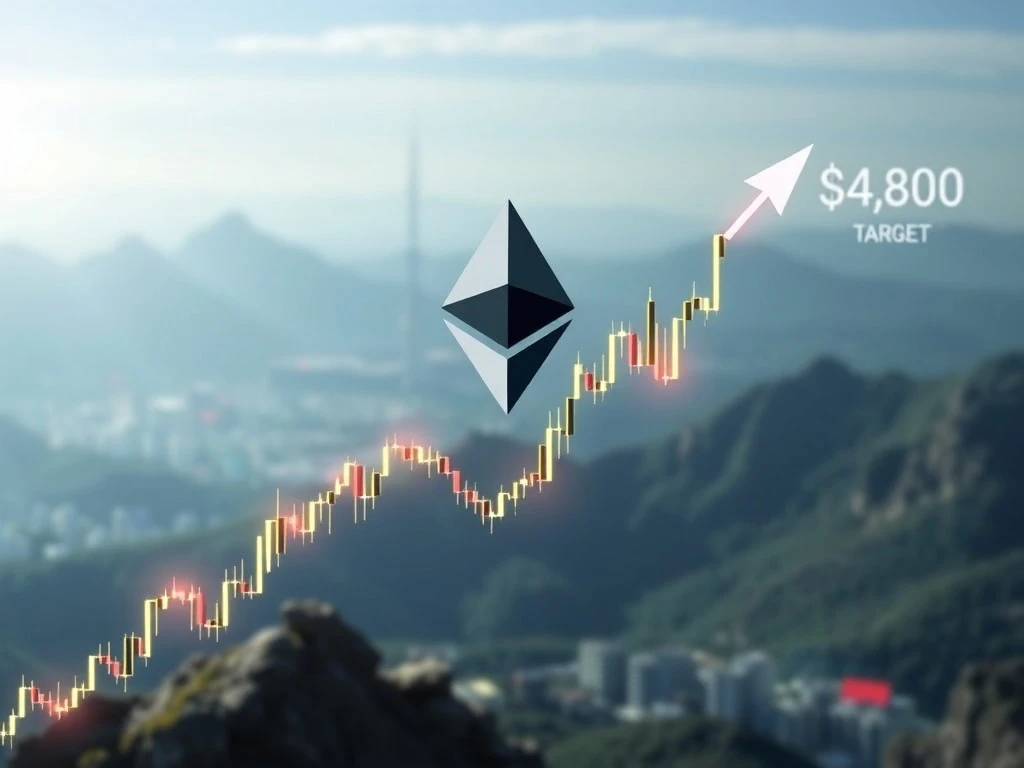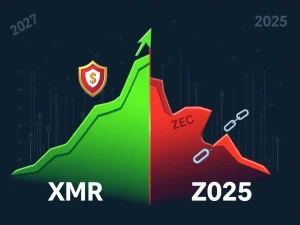Ethereum Price Explodes: Nearing $4,000 Resistance on Massive Institutional Accumulation and $4.6B ETH ETF Inflows, Eyes $6,000 Breakout

The cryptocurrency world is buzzing with excitement as the Ethereum price makes a decisive move towards the critical $4,000 resistance level. This isn’t just a typical market fluctuation; it’s a surge underpinned by significant institutional confidence and massive capital inflows, painting a compelling picture for Ethereum’s near-term future. Investors and enthusiasts alike are watching closely to see if the second-largest cryptocurrency can finally break through this psychological barrier and set its sights on new, ambitious targets like $6,000.
Ethereum Price Action: Testing the $4,000 Barrier
Ethereum (ETH) has demonstrated remarkable resilience and upward momentum, with its price recently touching $3,660 and seeing a notable 14.7% increase in 24-hour trading volume. This surge indicates strong buying interest, pushing ETH closer to the formidable $4,000 mark. This level isn’t just a number; it’s a significant psychological and historical resistance point that Ethereum has struggled to overcome consistently since 2021. A decisive breakthrough here would signal a major shift in market dynamics and open the door for further appreciation.
Current technical indicators also support this optimistic outlook. The Relative Strength Index (RSI) for Ethereum stands at 55, suggesting neutral momentum. This means there’s ample room for the price to climb higher without immediately triggering ‘overbought’ signals, which often precede pullbacks. The reduction in circulating supply, combined with increased trading volume, creates a favorable environment for continued price discovery.
Massive Inflows: The Impact of the ETH ETF
One of the most powerful catalysts driving the current surge is the unprecedented influx of capital into Ethereum Exchange-Traded Funds (ETFs). Over 15 consecutive days, these products have seen more than $4.6 billion in net inflows, underscoring robust institutional confidence in Ethereum’s long-term potential. This trend is particularly evident with products like BlackRock’s Ethereum ETF (ETHA), which has rapidly surpassed $10 billion in assets under management. These figures are not just statistics; they represent a significant vote of confidence from traditional finance, legitimizing Ethereum as a viable investment asset.
The impact of the ETH ETF cannot be overstated. For institutional investors, ETFs offer a regulated and accessible way to gain exposure to cryptocurrencies without directly managing digital assets. This convenience has facilitated a broader capital rotation from Bitcoin into Ethereum, as investors diversify their crypto holdings and seek exposure to ETH’s expanding utility in decentralized finance (DeFi), NFTs, and various blockchain applications. The record $440.1 million in daily inflows into BlackRock’s Ethereum ETF on July 16, 2025, serves as a testament to this burgeoning demand.
Institutional Accumulation: Whales and Strategic Moves
Beyond ETF inflows, on-chain data reveals a significant trend of institutional accumulation by large investors, often referred to as ‘whales.’ There has been a staggering 92% month-over-month surge in ETH accumulation by these entities. This indicates that sophisticated market participants are not just dipping their toes; they are making substantial, strategic investments in Ethereum. This kind of accumulation by ‘smart money’ often precedes major price movements.
A notable development observed by crypto analyst @rovercrc is the active closure of short positions by large institutional investors. This shift from a bearish to a bullish stance by major players can create a powerful upward momentum, as short covering (buying back borrowed assets to close a short position) adds further buying pressure to the market. When large entities reduce their bets against an asset, it often signals a collective belief that the price is poised for appreciation.
Broader Crypto Market Alignment: Bitcoin’s Role
Ethereum’s performance is intrinsically linked to the broader crypto market, particularly Bitcoin. As the market leader, Bitcoin’s stability above key levels, such as $60,000, can significantly amplify gains for ETH. Ethereum typically exhibits a higher beta to market cycles, meaning its price movements are often more pronounced than Bitcoin’s during both bull and bear markets. Therefore, a healthy and stable Bitcoin market provides a strong foundation for Ethereum’s continued ascent.
The overall sentiment within the crypto market remains a critical factor. Sustained institutional ETF flows, not just into Ethereum but across the board, are crucial. The announcement of a $6 billion facility by SharpLink Gaming, which now holds over 360,000 ETH, further highlights the increasing corporate adoption and conviction in Ethereum’s long-term value proposition. This kind of large-scale investment by public companies reinforces the institutional narrative and provides additional liquidity to the market.
Eyes on $6000 Ethereum: What’s Next?
With the $4,000 resistance firmly in sight, many analysts are now setting their sights on an ambitious target: $6000 Ethereum. This isn’t just wishful thinking; it’s a projection based on the confluence of strong fundamental and technical indicators. If the current bullish flows, driven by institutional demand and ETF inflows, continue unabated, breaking through the $4,000 barrier could trigger a significant rally towards this new high.
However, the journey to $6,000 will likely not be without its challenges. Short-term volatility persists, as evidenced by recent dips due to profit-taking. Traders are advised to monitor key support levels, particularly around $3,000–$3,200, where ETH has historically found stability during pullbacks. These levels represent crucial points where buyers have stepped in to prevent further declines. A sustained hold above these supports would reinforce the bullish trend.
Actionable Insights for Investors:
- Monitor Institutional Flows: Keep a close eye on daily ETF inflow data, especially from major players like BlackRock and Fidelity, as these will be key drivers.
- Watch Key Resistance and Support: The $4,000 resistance is paramount. Once breached, the focus shifts to establishing new support levels. Similarly, defendable support at $3,000-$3,200 is vital.
- Observe Bitcoin’s Performance: Bitcoin’s ability to maintain its price levels will provide a favorable backdrop for Ethereum’s continued growth.
- Understand Market Sentiment: While data is crucial, overall market sentiment, driven by news and social media, can also influence short-term movements.
In summary, Ethereum’s current trajectory towards $4,000 is strongly supported by a powerful combination of rising institutional participation, continuous ETF inflows, and strategic on-chain accumulation. While short-term price fluctuations are an inherent part of the crypto market, the prevailing technical and fundamental indicators suggest a strong potential for a breakout towards the ambitious $6,000 target. Investors are encouraged to remain vigilant, adapting to evolving market conditions and utilizing volume dynamics and institutional activity as primary signals for decision-making.
Frequently Asked Questions (FAQs)
Q1: Why is $4,000 a significant resistance level for Ethereum?
The $4,000 level is a significant psychological and historical resistance point for Ethereum because it has been a strong barrier since 2021. Breaking above it consistently would signal a new bullish phase and could trigger further upward momentum as previous resistance turns into support.
Q2: How do Ethereum ETFs impact ETH’s price?
Ethereum ETFs provide a regulated and accessible investment vehicle for institutional investors and traditional finance. Their significant net inflows inject substantial capital into the market, increase demand for ETH, and legitimize the asset, thereby driving up its price and reducing selling pressure as investors ‘hodl’ their assets within these vehicles.
Q3: What does ‘institutional accumulation’ mean for Ethereum?
‘Institutional accumulation’ refers to large-scale buying of Ethereum by major investment firms, hedge funds, and high-net-worth individuals (whales). This trend is significant because it indicates strong confidence from sophisticated investors, suggesting a belief in Ethereum’s long-term value and often preceding major price rallies.
Q4: What factors could drive Ethereum to $6,000?
Several factors could drive Ethereum to $6,000, including sustained institutional ETF inflows, a decisive breakout above the $4,000 resistance, continued strong on-chain accumulation by whales, a stable or rising Bitcoin price, and the ongoing expansion of Ethereum’s utility in DeFi and blockchain applications.
Q5: What are the primary risks to Ethereum’s current bullish trend?
The primary risks include short-term volatility due to profit-taking, a significant downturn in the broader crypto market (especially if Bitcoin falters), unexpected regulatory changes, and any potential shifts in institutional sentiment that could lead to ETF outflows. Traders should monitor support levels closely.










